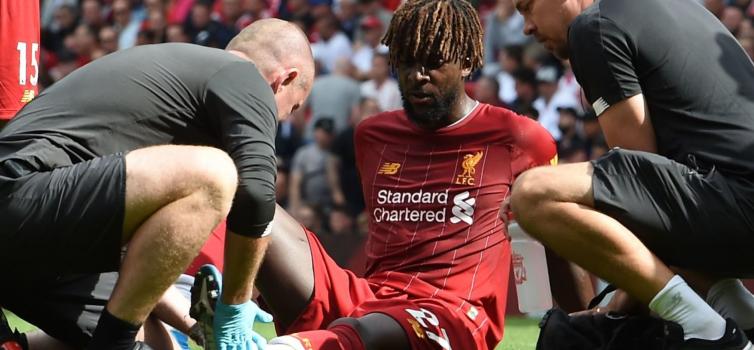Clubs urged to re-consider touchline surfaces after Origi injury

Origi will be out for up to two weeks following his injury against Newcastle
Written by Simon Austin — September 17, 2019
CLUBS need to re-think how close artificial grass is placed next to touchlines in their stadiums, according to a leading podiatrist and shoe surface researcher.
Athol Thomson, who works for the Aspetar centre in Doha, was speaking after Liverpool's Divock Origi suffered an ankle injury that will keep him out for up to two weeks against Newcastle on Saturday.
As you can see in the video below, the striker was chasing a ball near the touchline in the 37th minute of the Premier League game when he injured ankle ligaments. His ankle turned when he took a first step onto the artificial grass which is just inches from the touchline at Anfield.
Recent injury for a player stepping onto Artificial grass from a natural grass (hybrid reinforced) playing surface. The mechanical properties of each surface are most likely different (traction and hardness etc). This player had to come off with an ankle injury. pic.twitter.com/r0yLgHMxio
— Athol Thomson (@AtholThomson) September 16, 2019
Thomson, who has done extensive research on the interaction between players’ boots and playing surfaces, believes the change in traction between the two surfaces - the hybrid pitch and artificial grass - was a factor in the injury.
“Recent injury for a player stepping onto artificial grass from a natural grass (hybrid reinforced) playing surface,” he tweeted. “The mechanical properties of each surface are most likely different (traction and hardness etc). This player had to come off with an ankle injury.
“Change in traction (friction or grip) between the two surfaces seems an issue. Important to point out that artificial grass itself may not be the issue but the CHANGE in surface properties between the two surface types could be. It should be uniform.”
Thomson suggested that clubs should consider having a bigger run-off area, as is the case at Barcelona’s Nou Camp (below).

“Should an extra metre or two of the same uniform natural grass (or hybrid) surface be compulsory, like at Barcelona?" he asked. “Players can likely adapt to different surface conditions within a step via modifications to leg stiffness etc.
"Question is do cognitive tasks like chasing the ball and/ or pressure/ interaction with other players dull the ability of the player to "tune-in" to the surface changes?”
Former Liverpool Head Physio Andy Renshaw agreed: “In short, yes. Players don’t have time to think about adapting to a different surface when they’re chasing a ball. The same surface needs to remain beyond the line for a considerable distance.”
Thomson has previously written for TGG about how players adjust their leg stiffness, movement strategies and style of play according to the surface they interact with. This is why they wear different types of boots for different surfaces.



-1.png)





